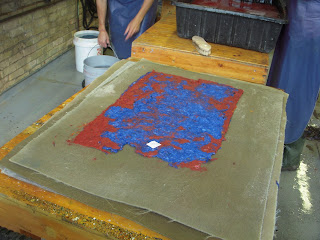I have been distracted by my new responsibilities in the middle school, not having as much free time to dedicate to folding or thinking about origami. ...And then something happened.
A student jumped out from around a corner to spook their friend. They were wearing paper claws! They had made a full set for both hands! In the action that followed, many of the claws fell to the floor and were forgotten. I collected them and put them on display in my room. Then I started thinking about all the origami that is perpetuated in schools, but is generally ignored by those who have moved on to more complicated models.
Nine paper claws.
Here I will take some time and identify the origami projects that have been introduced to me as schoolyard origami. Three of them I folded as a kid; two I have found at the school that I work at; one I found in
Picture-Perfect Origami by Nick Robinson and it is credited as a playground fold.
---Paper Claw---
The first time I came across this was while I was
teaching origami at the Brookdale Library one day. One student asked me if I knew how to fold them. When I said, "no," he quickly folded a prototype for me. A month or two later, I saw them again at the school.
They are a really simple design that starts with a regular sheet of paper (8.5in x 11in). I'll try and get a diagram up on the blog for those who wish to try it. Basically, it is a hollow triangle that fits over small fingers. It comfortably fits my pinky finger, but you can imagine a smaller hand having one on every finger including thumbs. It makes for an intimidating look (until they realize that the claws are made of paper).
---Paper Football---
When I was in elementary school, we got indoor recess when the weather was bad, or sometimes there would be no work to do, so we would play a game of paper football. This is also folded from a regular sheet paper (8.5in x 11in).
The rules to the game start out simple. The football is placed flat on the table. Each player takes turns hitting the football, trying to advance it closer to the opponent's side of the table. If the football stops with some of it hanging over the edge, that counts as a touchdown for 6 points and they may attempt to kick for an extra point. If the football slides over the edge completely and falls off, that is penalized, usually by giving the opponent an opportunity to score 3 points with a field goal kick. Some players develop more complicated rules that reflect every aspect of an NFL game.
---Ninja Star---
As a student, I folded my share of these and tried to toss them so that they would actually hit accurately. Alas, these are not particularly good weapons.
This model is part of the traditional repertoire, but has been adopted by the schoolyard crowd. It is odd among the models that I have learned in that it is build not from a single square or rectangle, but from two identical rectangles with the length being double the width.
---Fortune Teller---
This is also in the traditional repertoire, but is most often folded by grade school children. They write fortunes under the flaps and have people answer arbitrary questions which ultimately lead to one of the pre-written fortunes. We had a lot of fun with them when I was in school.
The design is really simple. Take a square; blintz fold; flip; blintz fold; fold in half to form a rectangle; put a finger into each of the four pockets. Or look it up on one of many websites.
---Basketball Hoop---
This is the model that I found in a book. I never played with one in school, but I can imagine it being as popular as the paper football.
I had a lot of fun trying to capture an image of the ball as it flew toward the basket. In the picture above, the blur just above the basket is the ball. The design is essentially a waterbomb base folded out of a rectangle so that the extra paper lifts the hoop above the desk.
---Bandoleer?---
I never saw these in school, but at my job the students make these large enough to drape them over one shoulder and across the body, so it looks like a really thin bandoleer or sash.
This really does not fall under the jurisdiction of origami as much as kirigami, but I felt I should include it because it is a natural extension of paper culture in schools. It does not appear to be related to an art project, but simply for the fun of it just like all the other examples above. Also, I doubt that there are enough examples of kirigami in schools to justify a list of its own. Simply put, all cutting tools are closely regulated in schools, whereas simple folding is not.
Sept 25th Update: The last model is actually the result of a scientific challenge. The teachers challenged their students to find a way to pass their entire body through a single 5inch x 3inch note card. The only way to do such a thing is to think outside the box.
------
So, that is the list so far. If I discover more models, I will write a post on them later.
[All photos are taken by me, of models folded by me or an unknown middle schooler.]
















































